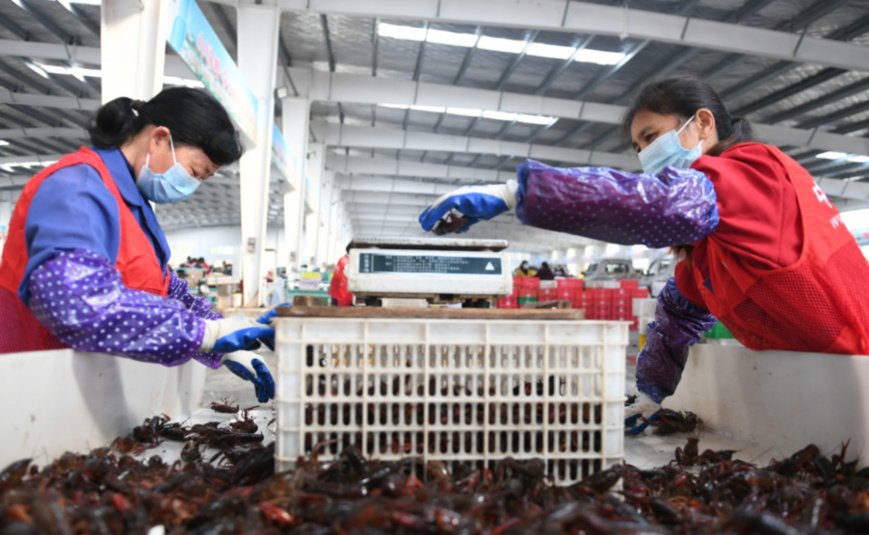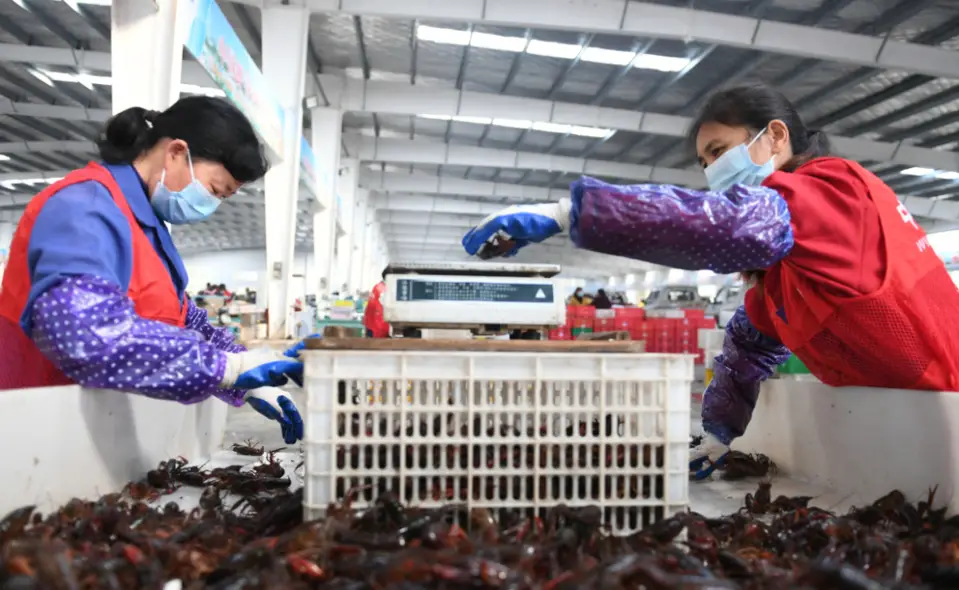Wang Xiaodong, People’s Daily

Employees sort crayfish at a crayfish trading center in Qianjiang city, central China’s Hubei province, March 17. Wu Yanjun/ People’s Daily Online
Known as China's crayfish city, Qianjiang in Hubei province has moved to make sure its crayfish industry well prepared for the peak crayfish season as the COVID-19 containment situation has improved.
Wang Hu runs an aquatic products business at a trading center in Qianjiang. He had just collected more than ten boxes of crayfish from local fishermen, and was sorting and packing the products before having them delivered to Shaoguan in eastern China’s Guangdong province.
“We could deliver about 2,000 kilograms of crayfish today. The figure is smaller compared with the previous level at 10,000 kilograms, but it is gradually increasing,” Wang said.
Affected by the COVID-19 epidemic, the trading center wasn’t open until it delivered the first batch of crayfish on Feb. 25. However, thanks to an online trading platform, the crayfish trade wasn’t suspended during the epidemic.
“The dealers could place an order on the platform, and after receiving the order, the crayfish growers collect and pack their products. The trading center is responsible for the logistics between the crayfish growers and the dealers,” said Wang Liqing, office manager of the trading center.
“We have more than 100 logistic vehicles to transport crayfish collected from the growers,” Wang disclosed, adding that about 40 percent of the crayfish have been sold online this year.
As the epidemic situation is further eased, dealers at various levels have started to enter the trading center after going through inspection and quarantine procedures.
“The market is enthusiastic about crayfish, and the government has rolled out favorable policies to support the industry, which injects confidence into us,” Wang Hu said, adding that the trading center will embrace a peak crayfish season in mid-to-late April.
Miaoxin village in Longwan township of Qianjiang promotes farming crayfish, rice, vegetables and fruit trees together to boost farmers' income. In a demonstration base covering more than 666.7 hectares of land, grape trees are sprouting new leaves.
“In the past, we planted rice only. Now, we also grow crayfish. Moreover, after the rice is harvested, we plant vegetables that can grow in water, and also fruit trees on the field ridge,” said Tang Yufa, Party chief of the village, who disclosed that farmers’ income has increased by 5,000 to 10,000 yuan by per mu, or 0.067 hectares of farmland.
The farms are equipped with real-time water quality and temperature monitoring systems to reassure buyers that the quality of the aquatic products is good, Tang introduced, saying that this will help expand sales channels for farmers.
Longwan township has endeavored to develop local industries amid epidemic prevention and control. It has set up a task force to remind villagers to follow epidemic prevention and control measures while they are farming in the fields.
“We’ve issued ‘farming permits’ to villagers who are not infected by the virus. We also ask them to take temperature before going out, farm in rotation, wear masks and report their activities. We’ve also employed vehicles to deliver farming materials and assigned technicians to offer guidance to farmers so as to stabilize agricultural production,” said Yu Yunxia, a member of the Party committee and deputy head of Longwan township.
Now, farming rice and crayfish has become a pillar industry of Miaoxin village. In addition, 26 farmers from the village have spread the technology to Jiangxi and Anhui provinces. “Half of the villagers in the town have become crayfish growers and the poverty-stricken villages have get rid of poverty and become better off through the special farming model,” Yu said.
Wang Hu runs an aquatic products business at a trading center in Qianjiang. He had just collected more than ten boxes of crayfish from local fishermen, and was sorting and packing the products before having them delivered to Shaoguan in eastern China’s Guangdong province.
“We could deliver about 2,000 kilograms of crayfish today. The figure is smaller compared with the previous level at 10,000 kilograms, but it is gradually increasing,” Wang said.
Affected by the COVID-19 epidemic, the trading center wasn’t open until it delivered the first batch of crayfish on Feb. 25. However, thanks to an online trading platform, the crayfish trade wasn’t suspended during the epidemic.
“The dealers could place an order on the platform, and after receiving the order, the crayfish growers collect and pack their products. The trading center is responsible for the logistics between the crayfish growers and the dealers,” said Wang Liqing, office manager of the trading center.
“We have more than 100 logistic vehicles to transport crayfish collected from the growers,” Wang disclosed, adding that about 40 percent of the crayfish have been sold online this year.
As the epidemic situation is further eased, dealers at various levels have started to enter the trading center after going through inspection and quarantine procedures.
“The market is enthusiastic about crayfish, and the government has rolled out favorable policies to support the industry, which injects confidence into us,” Wang Hu said, adding that the trading center will embrace a peak crayfish season in mid-to-late April.
Miaoxin village in Longwan township of Qianjiang promotes farming crayfish, rice, vegetables and fruit trees together to boost farmers' income. In a demonstration base covering more than 666.7 hectares of land, grape trees are sprouting new leaves.
“In the past, we planted rice only. Now, we also grow crayfish. Moreover, after the rice is harvested, we plant vegetables that can grow in water, and also fruit trees on the field ridge,” said Tang Yufa, Party chief of the village, who disclosed that farmers’ income has increased by 5,000 to 10,000 yuan by per mu, or 0.067 hectares of farmland.
The farms are equipped with real-time water quality and temperature monitoring systems to reassure buyers that the quality of the aquatic products is good, Tang introduced, saying that this will help expand sales channels for farmers.
Longwan township has endeavored to develop local industries amid epidemic prevention and control. It has set up a task force to remind villagers to follow epidemic prevention and control measures while they are farming in the fields.
“We’ve issued ‘farming permits’ to villagers who are not infected by the virus. We also ask them to take temperature before going out, farm in rotation, wear masks and report their activities. We’ve also employed vehicles to deliver farming materials and assigned technicians to offer guidance to farmers so as to stabilize agricultural production,” said Yu Yunxia, a member of the Party committee and deputy head of Longwan township.
Now, farming rice and crayfish has become a pillar industry of Miaoxin village. In addition, 26 farmers from the village have spread the technology to Jiangxi and Anhui provinces. “Half of the villagers in the town have become crayfish growers and the poverty-stricken villages have get rid of poverty and become better off through the special farming model,” Yu said.
 Menu
Menu
 Crayfish industry in Hubei province ready to boom
Crayfish industry in Hubei province ready to boom
















